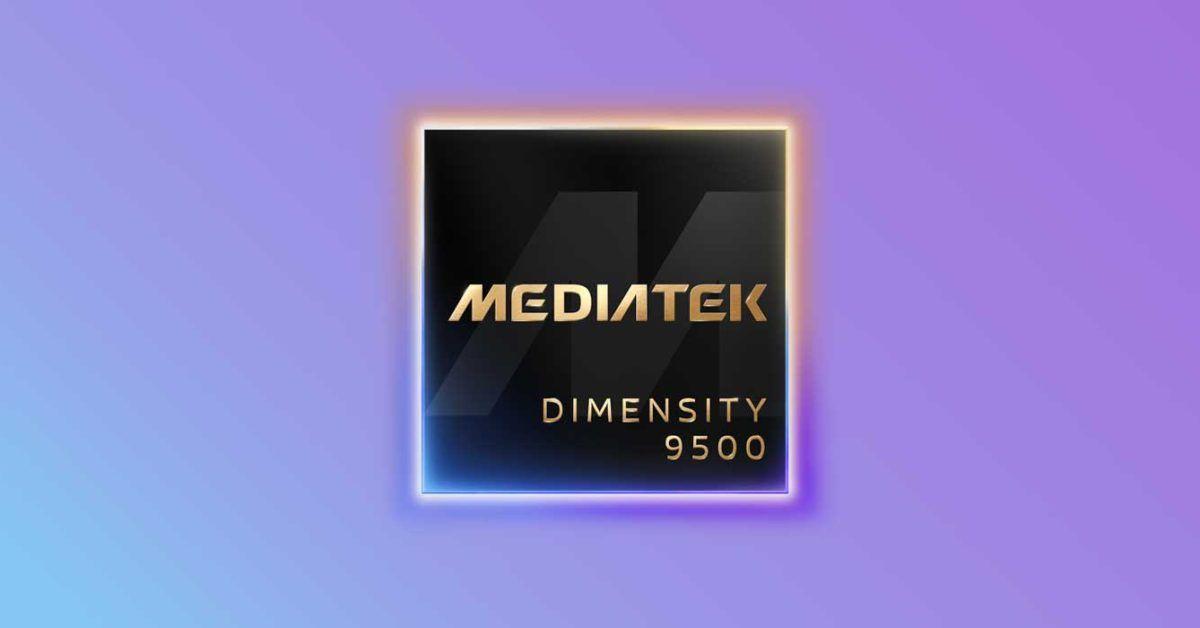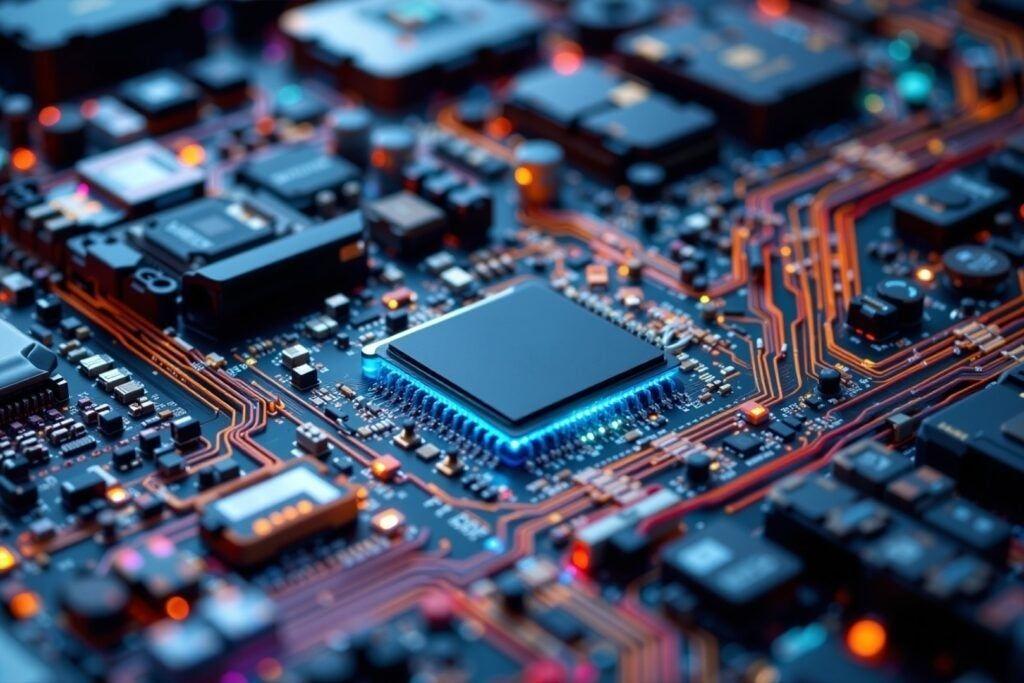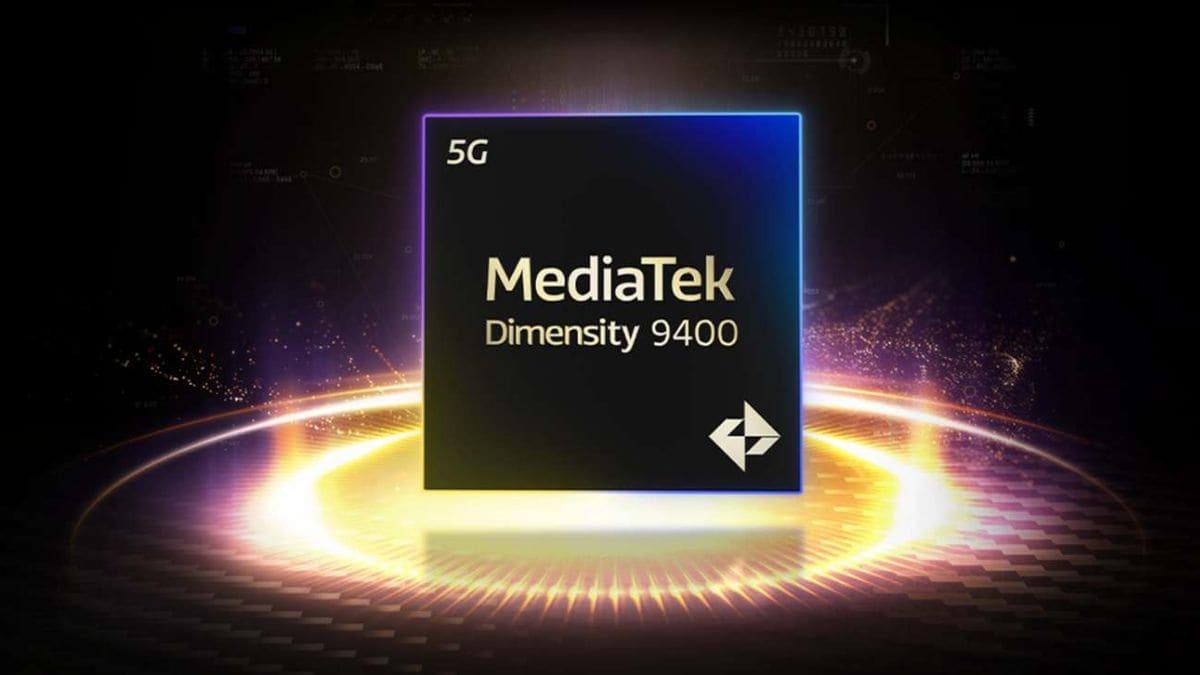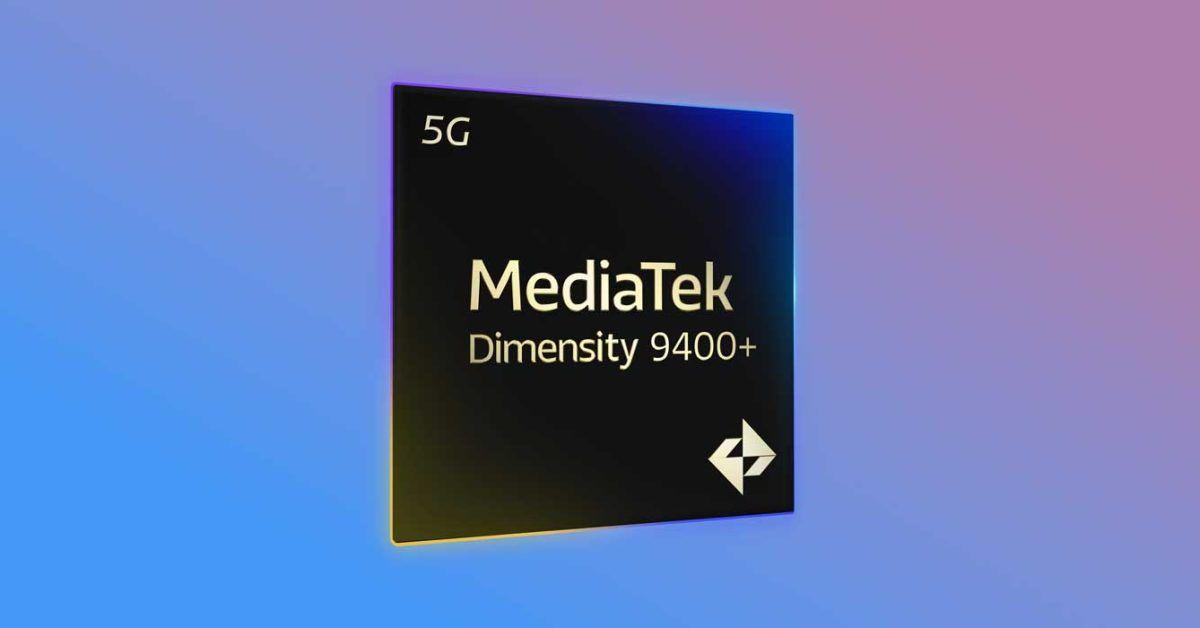MediaTek Unveils Dimensity 9500: A Powerful AI-Driven Chip for Next-Gen Android Flagships
11 Sources
11 Sources
[1]
MediaTek's Next Chip Will Boost Low-Power AI in Next Year's Top Android Phones
Expertise Smartphones | Gaming | Telecom industry | Mobile semiconductors | Mobile gaming MediaTek has unveiled its next big chip for premium Android phones, promising improvements for performance and AI operations. MediaTek's chip, the Dimensity 9500, debuts at a seemingly deliberate moment just days before Qualcomm is set to reveal its own silicon, the Snapdragon 8 Elite Gen 5. While we don't know the latter's performance metrics, it will almost certainly compete with the Dimensity 9500 to run the most powerful Android smartphones. The first phones running MediaTek's new chip will be Vivo and Oppo handsets launching in October for release in Europe, South America and Asia, but not the US yet. MediaTek's Dimensity 9500 has a mix of improvements over its predecessor, last year's Dimensity 9400. Its CPU cluster has 29% higher single-core and 16% higher multi-core performance, while also drawing 37% less power. Moving to Universal Flash Storage 4.1 (from UFS 4.0) enables memory, like in RAM, to read and write twice as fast. This also leads to 40% faster loading for large AI models, MediaTek said. Don't miss any of our unbiased tech content and lab-based reviews. Add CNET as a preferred Google source. The Dimensity 9500 roughly follows the design of MediaTek's last few high-end chips. Its CPU cluster features an array of Arm's newly-renamed C1-series silicon: one Arm C1-Ultra at 4.21 GHz, three Arm C1-Premium at 3.5GHz and four Arm C1-Pro at 2.7GHz. For gaming, the Dimensity 9500's graphics processing unit has 33% improved performance and is 42% more energy efficient, meaning longer play sessions on a device before needing to recharge it. The chip also doubles the performance of ray tracing, a technology enabling realistic shadows and reflections in mirrors and water surfaces that often pushes GPUs to their limits. The chip can render graphics at up to 120 frames per second with ray tracing turned on, and also supports graphics engines like Vulkan 1.4 and Unreal Engine 5.6. Given the aggressive adoption of AI on mobile, it's unsurprising that MediaTek also boosted artificial intelligence on its new chip. The Dimensity 9500's NPU 990 has a smattering of upgrades over its predecessor, with 100% faster processing for the smaller 3 billion parameter models often used on smartphones (which typically top out at 7 billion parameters). The NPU (neural processing unit) is also 42% more power efficient when running small AI models. Finally, the mobile chip is the first in the industry to generate 4K images with AI, MediaTek said. For large language models, the Dimensity 9500 is the first mobile chip to support BitNet 1-bit, which leads to 50% lower power consumption of LLMs. The chip's upgrades to camera processing include support for 4K portrait videos at 60 frames per second, as well as slow-motion 4K video at 120 FPS with Dolby Vision video that's optically stabilized. The Dimensity 9500 carries on its predecessor's support for up to 200-megapixel cameras. The Dimensity 9500 also claims connectivity boosts over its predecessor, including 5CC carrier aggregation that increases bandwidth by 15%.
[2]
MediaTek Launches Improved AI Processor to Compete with Qualcomm
MediaTek Inc. is launching a mobile processor more capable of handling agentic AI tasks on devices, positioning to better compete with Qualcomm Inc. The new Dimensity 9500 will provide users with better summaries of calls and meetings, improved output from AI models and superior 4K photos, the Taiwanese company said in a statement. The chip is made using an advanced 3-nanometer process by Taiwan Semiconductor Manufacturing Co., according to MediaTek, and handsets carrying the new chip will become available in the fourth quarter.
[3]
MediaTek challenges Qualcomm with new Dimensity 9500 3nm flagship chip
Serving tech enthusiasts for over 25 years. TechSpot means tech analysis and advice you can trust. First look: MediaTek has unveiled the Dimensity 9500, its latest mobile processor designed to push AI performance directly to smartphones and compete in the flagship tier. Built on TSMC's advanced 3nm process, the SoC will debut in new handsets from brands such as Vivo and Oppo beginning in late 2025. The launch puts MediaTek squarely into a renewed battle with Qualcomm, whose Snapdragon 8 Elite Gen 5 processor will power rival devices from manufacturers such as Xiaomi. Both chips employ "all-big-core" CPU architectures and dedicated hardware for generative AI, signaling how the premium smartphone market has become defined by technical firepower rather than rapid expansion. Preliminary analysis suggests that MediaTek's processor could take a slight lead in single-core performance, while Qualcomm maintains advantages in multi-core benchmarks. For handset makers contending with Apple's iPhone at the high end, these distinctions are increasingly critical. The Dimensity 9500 integrates a 4.21 GHz ultra core, three additional premium cores, and four performance cores to balance speed and efficiency. Paired with four-lane UFS 4.1 storage, it supports faster multitasking and high-intensity AI model execution. MediaTek reports up to 55 percent lower power consumption during peak performance and as much as 30 percent greater efficiency when running demanding applications. AI processing is handled by the ninth-generation NPU 990, enabling generative tasks and large language models to run continuously through a compute-in-memory design intended to save energy. Imaging advances arrive through the Imagiq 1190 ISP, which works with 200MP sensors, supports RAW-domain pre-processing, and captures 4K video at 60 frames per second. Meanwhile, the MiraVision Adaptive Display system automatically adjusts brightness to ambient conditions, curbing heat and extending battery life. In terms of connectivity, the platform incorporates upgraded Bluetooth calling, AI-assisted network optimization, and enhanced positioning accuracy. MediaTek is also looking to diversify chip sourcing by allocating some production volume through TSMC's Arizona facility. Though MediaTek projects only a modest 1 percent to 2 percent increase in global smartphone shipments over the next year, the company is targeting strength at the top of the market. Oppo and Vivo's adoption of the Dimensity 9500 positions the chip against Xiaomi's Snapdragon-powered flagships, a contest that reflects how cutting-edge AI, imaging, and energy performance now define success in the premium device space.
[4]
Meet the monster MediaTek chip set to power some of the best phones out there
The best smartphones in the world coming out over the next year or so will use one of two different processors, and MediaTek has introduced its entry into the race on September 22, called the Dimensity 9500. The chip features an all-new big-core design, console-level ray-tracing, and an efficient yet powerful NPU with double the AI performance over previous generations. It's built using the cutting-edge third generation 3nm process at TSMC's foundry, and introduces us to ARM's latest C1 CPU cluster. This consists of a single, 4.21GHz ARM C1 Ultra core, three 3.5GHz ARM C1 Pro cores, and four 2.7GHz ARM C1 Pro cores, returning 32% higher single core performance and 37% lower power consumption over the Dimensity 9400. From the GPU to the AI MediaTek has also chosen the new ARM Mali-G1 Ultra GPU, making it capable of 120fps ray traced gameplay, and twice the overall ray tracing unit performance from the previous chip. MediaTek expects a 33% jump in performance and a 42% increase in efficiency. For AI, MediaTek has built the NPU 990, its most powerful NPU to date, with a new generative AI Engine for reduced bandwidth use, lower power consumption, and improved on-device AI processing. It supports always-on small models with a 40% decrease in energy consumption. There's also the MediaTek Imagiq 1190 ISP for up to 200-megapixel images and 4K 60fps portrait video, NPU-assisted focusing, and RAW-domain pre-processing, along with the first four-lane UFS 4.1 memory for double the read/write speeds, plus the Dimensity 9500 will be the first Android processor to support 1 nit ultra dark screens. First phones coming soon MediaTek's corporate senior vice president JC Hsu said: As AI becomes part of everyday life, consumers want devices that feel smarter, faster, and more personal without sacrificing battery life. The MediaTek Dimensity 9500 delivers exactly that: Breakthrough on-device AI, top-tier performance and efficiency, and a full suite of premium experiences that our partners can bring to users around the world. The first phones with the Dimensity 9500 will arrive before the end of the year, and MediaTek expects the initial devices to launch in Europe around October, with Oppo and Vivo leading the way. In related news, expect to learn more about the Qualcomm Snapdragon 8 Gen 5, the other top phone processor to know about, over the next few days.
[5]
MediaTek's Dimensity 9500 is ready for Android flagships before end of year
MediaTek's new Dimensity 9500 marks the company's third-generation "all big-core" SoC. This build takes big leap with gaming performance and AI processing. Internally, the Dimensity 9500 is made up of 8 cores built on Arm's C1-Ultra, C1-Premium, and C1-Pro processors built on a 3nm process. The "big-core" design was pioneered by the Dimensity 9300, though MediaTek seems to be much more interested in the new approach in comparison to other chipmakers. Qualcomm still utilizes a combination of performance and smaller efficiency cores. The new flagship processor offers several performance boosts over the previous generation. MediaTek's stats say the SoC is 55% more efficient at peak performance and 16% better in multi-core performance. The chip also uses UFS 4.1 storage for faster AI with four storage lanes. A 9-th 9th-generation NPU 990 takes on the load of AI processing. The NPU's power has doubled with better power efficiency using always-on "small models." The Dimensity 9500 will, according to MediaTek, allow Android devices to generate 4K images using on-board processing. The NPU also allows for low-bit support, making large quantities of small processes more efficient, especially for Gemini throughout Android. Organically captured images get an upgrade, too. Devices with the Dimensity 9500 will be able to support up to 200MP processors and NPU-assisted focusing. The more exciting bump in performance comes in the form of more frames and better hardware-accelerated ray-tracing. The Dimensity 9500 uses an Arm G1-Ultra GPU that offers higher peak performance and 119% faster raytracing benchmarks. Games with ray-tracing should be reproduced at 120fps with the new SoC, though time will tell if real-life performance agrees. MediaTek says that flagship devices from Vivo and Oppo are expected in Q4 2025, which is any time from now until the end of the year.
[6]
MediaTek unveils Dimensity 9500 AI chip
MediaTek announced on September 22, 2025, the launch of an improved AI processor, potentially a new Dimensity 9500 iteration. The chip is engineered to enhance native on-device AI capabilities in mobile hardware and to compete directly with processors from Qualcomm. This release is part of a broader company strategy to make AI computing efficient and accessible across a range of platforms, including smartphones, automotive systems, Internet of Things devices, and cloud infrastructure. The initiative builds upon MediaTek's recent technological progress, which includes the development of its first 2nm chip. A partnership with NVIDIA to develop next-generation AI systems further supports the company's focus on advancing its AI compute power and silicon technology. Smartphone manufacturers Xiaomi and Vivo are expected to incorporate the new processor into their upcoming devices. The first products featuring MediaTek's new AI technology are anticipated to launch in the fourth quarter of 2025. This release schedule positions the hardware to compete not only with Qualcomm but also with Apple's upcoming AI-powered devices, aligning with MediaTek's goal to establish a leading role in edge-to-cloud AI computing solutions.
[7]
MediaTek Dimensity 9500 Brings Console Gaming and Powerful AI to Flagship Phones - Phandroid
MediaTek just dropped a bombshell in the flagship chipset race. The new MediaTek Dimensity 9500 promises to shake up the premium smartphone game with some seriously impressive specs that put it head-to-head with the best Qualcomm has to offer. The MediaTek Dimensity 9500 adopts a third-generation All Big Core CPU design that's all about raw power. But what does this mean? Most smartphone chips use a mix of different types of processor cores to balance performance and battery life. It's like having both a sports car and an economy car in your garage. You'd use the economy car for daily errands (saving gas) and the sports car when you need speed. Traditional chips have small "efficiency" cores for basic tasks like checking messages, and bigger "performance" cores for demanding stuff like gaming. Going "All Big Core" means MediaTek is ditching the economy car and putting pedal to the metal. We're looking at a 4.21GHz ultra core working alongside three premium cores and four performance cores, plus four-lane UFS 4.1 storage support. This will result in up to 29% higher single-core performance and 16% higher multi-core performance compared to the previous generation. That ultra core achieves up to 55% lower power consumption at peak performance. What does this mean for you? Your phone stays fast while your battery lasts longer. The platform's new cache and memory architecture includes industry-first support for 4-channel UFS4.1, which doubles read/write speeds and accelerates large AI model loading by 40%. If you're a gamer, buying a Dimensity 9500 powered phone could be a good idea. The Dimensity 9500 integrates the Arm G1-Ultra GPU, delivering up to 33% higher peak performance and 42% improved power efficiency. It boasts double frame rate interpolation up to 120FPS, so you can enjoy console-level raytracing right on your phone. MediaTek isn't just throwing around buzzwords either. They've partnered with leading studios and added support for MegaLights in Unreal Engine 5.6 and Nanite in Unreal Engine 5.5. This enables AAA-level real-time rendering and immersive lighting effects that were previously impossible on mobile devices. If you've been waiting for mobile gaming to truly rival console experiences, this might be your moment. The MediaTek Dimensity 9500 delivers what MediaTek calls "truly agentic AI UX" with proactive, personalized, collaborative, evolving, and secure AI features. The ninth-generation MediaTek NPU 990 with Generative AI Engine 2.0 doubles compute power and introduces BitNet 1-bit large model processing, reducing power consumption by up to 25%. The ultra-efficient NPU enables always-on small models, slashing power consumption by more than 40%. Users get 100% faster 3 billion parameter LLM output, 128K token long text processing, and the industry's first 4K ultra-high-resolution image generation. This isn't just AI for the sake of AI. These are practical features that actually improve how you use your phone. Photography gets a major boost with MediaTek Imagiq 1190, supporting RAW-domain pre-processing, up to 200MP capture, and NPU-assisted focusing. The platform enables cinematic 4K 60FPS portrait video, taking mobile videography to the next level. On the connectivity front, you're getting MiraVision adaptive display, AI-driven Bluetooth call enhancement, Wi-Fi fast transfer, and multi-network intelligence for seamless calls and data. AI-powered communication technologies deliver up to 10% lower power in 5G and 20% lower power in Wi-Fi scenarios, while 5CC carrier aggregation boosts bandwidth by 15%. AI positioning and network selection technologies offer 20% higher accuracy and 50% lower network latency lag compared to competitors. Flagship smartphones powered by the MediaTek Dimensity 9500 are expected to arrive in the fourth quarter of 2025.
[8]
Here's why you need a MediaTek Dimensity 9500 in your next flagship phone | Stuff
Power-hungry smartphone shoppers will have to think hard over what powers their next purchase. MediaTek has just unveiled the new Dimensity 9500 chipset, which is set to go toe-to-toe with Qualcomm's latest Snapdragon CPUs over the next few months and into 2026. The last few Dimensity hero models saw MediaTek make huge inroads into what's traditionally been Qualcomm territory, with big performance jumps and impressive power efficiency. It's no coincidence the Oppo Find X8 Pro and Vivo X200 Pro were some some of the longest-lasting phones I tested in 2025 (though colossal battery capacities certainly help). This latest effort promises to be even more battery-friendly, while also bringing faster on-device AI and console-class gaming. Each chipset is packing eight cores, including a single ultra core good for up to 4.21GHz, three premium cores, and four performance cores. MediaTek reckons it's good for a 32% boost to single core performance and 17% multi-core improvement. Apps that rely on the ultra core will see up to 55% reduced power consumption, while games and multitasking that use multiple cores should see closer to a 30% improvement. MediaTek is also officially first out the gate with support for 4-channel UFS4.1 storage, which could mean double the read and write speeds over previous top-tier smartphones. That'll be a major boost for on-device AI, as loading large language models will be up to 40% quicker now. Pure number crunching ability has essentially doubled, while power consumption has dropped by a third. Dimensity 9500-powered phones will also be able to create generational AI images in 4K for the first time. On the photography front, the image signal processor (ISP) will be able to handle 200MP sensors, 30fps continuous focus tracking, and portrait video recording at 4K/60fps. Gaming could see the biggest gains, with support for two of the biggest new bits of tech in Unreal Engine 5.5: MegaLights direct lighting and Nanite geometry. The two are in regular use on PS5 and Xbox Series X games built on Epic's software, and mobile support could pave the way to more ambitious console ports. 33% higher peak performance and ray tracing support at 120fps will certainly help there. The first Dimensity 9500-powered phones are due before the end of the year, with Oppo and Vivo the most likely candidates. Samsung also has priors for using MediaTek chips in its top-end Android tablets. MediaTek's announcement was cannily timed to pre-empt rival Qualcomm, which is set to reveal all the details about its own flagship mobile chip - Snapdragon 8 Elite Gen 5 - at its Snapdragon Summit later this week.
[9]
Can MediaTek's New Chip Take On Qualcomm? - Apple (NASDAQ:AAPL), Advanced Micro Devices (NASDAQ:AMD)
MediaTek, a key player in Taiwan's mobile chip industry, has strategically launched its new Dimensity 9500 mobile processor, intensifying its competition with Qualcomm QCOM in the race to power on-device agentic artificial intelligence. This advanced chip, built on Taiwan Semiconductor Manufacturing Co.'s TSM 3-nanometer process, is engineered to deliver significant improvements, including sharper 4K photos, enhanced AI model performance, and smarter summaries of calls and meetings. Smartphones equipped with the Dimensity 9500 are expected to reach the market in the fourth quarter, Bloomberg reported on Monday. Also Read: Qualcomm And Google Cloud Forge AI Alliance To Transform Cars Into Smart Agents The launch comes as Xiaomi XIACY prepares to unveil its latest Qualcomm Snapdragon-powered lineup this week, aiming to challenge Apple's AAPL iPhone 17. MediaTek, by contrast, is positioning its new processor to support Chinese brands such as Vivo in competing more effectively in the premium smartphone segment. Despite the rollout, company executives remain cautious about broader market conditions. MediaTek projects that global smartphone shipments may expand only 1%-2% in 2025, with subsidies that briefly lifted demand in China unlikely to offset overall sluggish growth. To mitigate security concerns among its U.S. customers, MediaTek also intends to shift a portion of its chip production for automotive and other sensitive applications to Taiwan Semiconductor's Arizona facility. The company is currently in negotiations with Taiwan Semiconductor to formalize this move, which would align with the Taiwanese contract chipmaker's expanding U.S. operations. The Arizona plant recently reported its first profit four years after its inception and already serves key clients including Apple, Nvidia NVDA, and Advanced Micro Devices AMD. The facility commenced 4-nanometer mass production in late 2023 and is preparing a second fab for 3-nanometer output. Further cementing their long-standing partnership, MediaTek has received approval from Taiwan Semiconductor to utilize its next-generation 2-nanometer process for a new flagship System-on-a-Chip (SoC), expected to be branded the Dimensity 9600. Mass production for this advanced chip is targeted for late 2025, with a market release anticipated in 2026. Image via Shutterstock AAPLApple Inc $255.30-0.30% Overview AMDAdvanced Micro Devices Inc $160.410.39% NVDANVIDIA Corp $181.96-0.90% QCOMQualcomm Inc $169.69-0.02% TSMTaiwan Semiconductor Manufacturing Co Ltd $283.203.88% XIACYXiaomi Corp $36.190.50% Market News and Data brought to you by Benzinga APIs
[10]
MediaTek Dimensity 9500 SoC Revealed: Price and Specifications
MediaTek has just announced the Dimensity 9500 SoC for the global market. The chipset is first likely to be featured on the Vivo X300 series in China. The expected launch is in October. Then, other OEMs (original equipment makers) are also likely going to use the chip on their phones and tablets. The chipset has been made with focus on enabling better handling of AI (artificial intelligence) tasks. The chipset comes with the third-generation All Big Core CPU design, combining a 4.21 GHz ultra core, three premium cores, and four performance cores. There will be four lane UFS 4.1 storage support. Read More - MacBook Air M4 Price Falls Further in India The new chipset's CPU design supports 29% higher single core score and a 16% higher multi-core performance compared to the previous generation. The ultra-core achieves up to 55% lower power consumption at peak performance. JC Hsu, corporate senior vice president at MediaTek and general manager of the Wireless Communications Business Unit said, "As AI becomes part of everyday life, consumers want devices that feel smarter, faster, and more personal without sacrificing battery life. The MediaTek Dimensity 9500 delivers exactly that: Breakthrough on-device AI, top-tier performance and efficiency, and a full suite of premium experiences that our partners can bring to users around the world." Read More - Vodafone Idea AGR Issue: What's Happening The GPU is improved and it delivers up to 33% higher peak performance and 42% improved power efficiency. Gamers can now enjoy console level ray tracing with the chipset, said MediaTek in a release. The Dimensity 9500 SoC delivers truly agentic AI UX, the company said. There's the ninth generation NPU 990 integrated on the chip with Generative AI Engine 2.0, resulting in double the compute power and it also introduces BitNet 1-bit large model processing, reducing the power consumption by 25%. The camera performance has also been enhanced. The Dimensity 9500 supports RAW-domain pre-processing, up to 200MP capture, and NPU-assisted focusing. The chipset's power consumption with 5G has been improved 10%, that might result in better battery life for the devices.
[11]
MediaTek Dimensity 9500 3nm SoC official
MediaTek just announced Dimensity 9500, the company's latest flagship SoC, as the successor to Dimensity 9400 / 9400+ as it had announced. It uses third-generation TSMC's 3nm process tech and the third-generation all-large core CPU architecture. Compared to the previous generation, the Dimensity 9500 flagship chip all-new C1-Ultra core, boasting a 10% increase in IPC over the previous generation. It also features C1-Premium and C1-Pro cores. The MediaTek Dimensity 9500 has a 4.21GHz C1 ultra core, three premium C1 cores at 3.5GHz, and four C1 Pro performance cores, with four-lane UFS 4.1 storage. This design promises up to 32% higher single-core and 17% higher multi-core performance compared to the previous generation, while the ultra core achieves up to 55% lower power consumption at peak performance, giving users longer battery life and greater productivity, says MediaTek. The 9500 is also up to 30% more power efficient while multitasking in games and social audio call apps, adds the company. The platform's new cache and memory architecture, including the industry's first support for 4-channel UFS4.1, doubles read/write speeds and accelerates large AI model loading by 40%. The second-generation Dimensity Scheduling Engine translates this raw power into smoother responsiveness and sustained efficiency, even under heavy workloads. The Dimensity 9500 integrates a new Arm G1-Ultra GPU promising up to 33% higher peak performance and 42% improved power efficiency, and introduces higher frame rate interpolation up to 120FPS ray tracing. MediaTek's collaboration with leading studios, along with support for MegaLights in Unreal Engine 5.6 and Nanite in Unreal Engine 5.5, enable AAA-level real-time rendering and immersive lighting effects, said the company. The Dimensity 9500 integrates the ninth-generation MediaTek NPU 990 with Generative AI Engine 2.0 doubles compute power and introduces BitNet 1.58-bit large model processing, reducing power consumption by up to 33%. Doubling its integer and floating-point computing capabilities, users benefit from 100% faster 3 billion parameter LLM output, 128K token long text processing, and the industry's first 4k ultra-high-definition image generation; all while slashing power consumption at peak performance by 56%, said the company. The Dimensity 9500 is the first to support an integrated compute-in-memory architecture for its newly-added Super Efficient NPU, significantly reducing power consumption and enabling AI models to run continuously. This advancement further enhances end-user experiences with more sophisticated proactive AI. With MediaTek Imagiq 1190, the MediaTek Dimensity 9500 supports RAW-domain pre-processing, up to 200MP capture, 30fps continuous focus tracking, and new portrait engine, while enabling cinematic 4K 60FPS portrait video. This offers Android's first 4K120 Dolby Vision video capture with EIS. The latest MiraVision Adaptive Display technology, which dynamically adjusts contrast and color saturation based on ambient lighting, panel characteristics, and real-time content analysis. This ensures a clear viewing experience both outdoors in high-brightness scenarios -- without overheating during prolonged use -- and indoors in extremely dark environments, providing eye protection while maintaining clarity. The platform's connectivity suite includes Bluetooth call enhancement, Wi-Fi fast transfer, and multi-network intelligence for seamless calls and data. AI-powered communication technologies deliver up to 10% lower power in 5G and 20% lower power in Wi-Fi scenarios, while 5CC carrier aggregation boosts bandwidth by 15%. AI positioning and network selection technologies offer 20% higher accuracy, as well as 50% lower network latency thanks to AI congestion prediction. vivo X300 series that will be introduced in China on October 13th will be the first to use the Dimensity 9500 flagship chip. The vivo X300 series will feature V3+ imaging chip. It promises stronger performance, better energy efficiency, and deeper image fusion. OPPO has also confirmed that its Find X9 series which will be introduced on October 16th will use the Dimensity 9500 flagship chip. Commenting on the new chip, JC Hsu, corporate senior vice president at MediaTek and general manager of the Wireless Communications Business Unit, said:
Share
Share
Copy Link
MediaTek's latest Dimensity 9500 chip promises significant improvements in AI processing, gaming performance, and energy efficiency for high-end Android smartphones, challenging Qualcomm's dominance in the market.
MediaTek's Dimensity 9500: A Flagship for Next-Gen AI Smartphones
MediaTek introduces its Dimensity 9500, a 3nm processor for premium Android devices, challenging Qualcomm and marking its robust entry into the high-end mobile market .

Source: 9to5Google
Breakthrough AI, Core Performance & Graphics
The Dimensity 9500 features a ninth-gen NPU 990, doubling AI performance, boosting power efficiency by 42%, and supporting BitNet 1-bit technology for 50% less LLM power and on-device 4K image generation . Its "all-big-core" CPU, with an Arm C1-Ultra, delivers a 29% single-core and 16% multi-core boost with 37% less power. The Arm Mali-G1 Ultra GPU improves graphics performance by 33% and efficiency by 42%, enabling 120 fps ray tracing for gaming .

Source: Benzinga
Related Stories
Advanced Imaging and Global Market Push
Robust imaging supports up to 200-megapixel cameras, 4K 60 fps OIS portrait videos, and 4K 120 fps slow-motion with Dolby Vision. RAW-domain pre-processing and 1 nit ultra-dark screen support enhance visuals . Vivo and Oppo are expected to adopt the Dimensity 9500 first, launching across Europe, South America, and Asia by late 2025. This strategic rollout aims to redefine the premium Android experience via cutting-edge AI and efficiency .

Source: Android Police
References
Summarized by
Navi
Related Stories
MediaTek Unveils Dimensity 9400: A Powerful AI-Focused Mobile Chip
08 Oct 2024•Technology

MediaTek Dimensity 9500: Next-Gen Chipset with Enhanced AI and Ray Tracing Capabilities
29 Apr 2025•Technology

MediaTek Unveils Dimensity 9400+ SoC: Enhanced AI Performance and Gaming Capabilities for Flagship Smartphones
11 Apr 2025•Technology

Recent Highlights
1
Google launches Gemini 3 Flash as default AI model, delivering speed with Pro-grade reasoning
Technology

2
OpenAI launches GPT Image 1.5 as AI image generator war with Google intensifies
Technology

3
OpenAI launches ChatGPT app store, opening doors for third-party developers to build AI-powered apps
Technology





